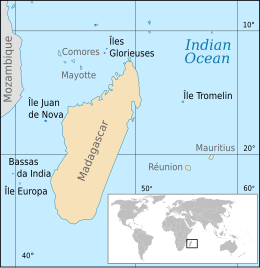Glorioso Islands
This article needs additional citations for verification. (December 2009) |
Glorioso Islands Îles Glorieuses (French) | |
|---|---|
|
Flag | |
| Motto: Liberté, égalité, fraternité "Liberty, Equality, Brotherhood" | |
| Anthem: "La Marseillaise" |
| Disputed island | |
|---|---|
 The Glorioso Islands seen from the ISS, 2001. Grande Glorieuse (left) and Île du Lys (right) | |
 Map of the Scattered Islands in the Indian Ocean | |
| Geography | |
| Location | Mozambique Channel |
| Coordinates | 11°33′S 47°20′E / 11.550°S 47.333°E |
| Administration | |
| Overseas territory | French Southern and Antarctic Lands |
| District | Scattered Islands in the Indian Ocean |
| Claimed by | |
The Glorieuses or Glorioso Islands (
Archipelago
The archipelago consists of two islands, Grande Glorieuse (11°34′46.54″S 47°17′54.14″E / 11.5795944°S 47.2983722°E) and Île du Lys, as well as eight rock islets (Roches Vertes): Wreck Rock (11°30′45.19″S 47°22′54.17″E / 11.5125528°S 47.3817139°E), South Rock (11°35′43.76″S 47°18′6.66″E / 11.5954889°S 47.3018500°E) and Verte Rocks (11°34′15.63″S 47°19′54.18″E / 11.5710083°S 47.3317167°E) and three other rocks that are unnamed. They form part of a coral reef and lagoon. Grande Glorieuses is roughly circular and measures about 3 kilometres (1.9 mi) across. It is thickly vegetated, mainly by the remains of a coconut plantation and casuarina trees.
Île du Lys, located at 11°30′59.35″S 47°22′36.02″E / 11.5164861°S 47.3766722°E about 8 kilometres (5.0 mi) northeast of Grande Glorieuses, is about 600 metres (2,000 ft) long and consists of sand dunes and scrub with some mangroves. It was formerly quarried for phosphate (guano).
The Glorieuses have an
Climate
The climate is tropical and the terrain is low and flat, varying in height from sea level to 12 metres (39 ft). Île de Lys in particular is a nesting ground for migratory seabirds, and turtles lay eggs on the beaches. In the ocean, migratory species such as humpback whales and whale sharks may appear.[1]
History
While probably earlier known to Arab (perhaps especially Yemeni) navigators, the Glorieuses were named and settled in 1880 by a
Historically flora on the islands mostly consisted of bois de rose, portia, banyan and other large native trees, many of which were felled following the establishment of the French settlement and plantation.[3]
From 1914 to 1958, concessions to exploit the islands were given to
In 2012, France founded Glorioso Islands Marine Natural Park, a marine protected area, to preserve the endangered flora and fauna of the islands.[7]
Gallery
-
Map
-
Island overview
See also
- France–Seychelles Maritime Boundary Agreement
- Moheli Marine Park
- Glorioso Islands Marine Natural Park
References
- ^ Glorioso Islands (images). Retrieved 16 September 2017.
- ^ The World Factbook. Central Intelligence Agency. 2008. p. 211. Retrieved 3 March 2024.
- ISSN 0096-3801.
- ^ "Foreign Legion Detachment in Mayotte | French Foreign Legion Information". Retrieved 3 February 2021.
- ^ "Disputes - International". CIA World Factbook. Archived from the original on 20 October 2011. Retrieved 8 November 2011.
- ^ "Comoros hits back against France over visa suspension". Reuters. Retrieved 11 April 2021.
- ^ "Le Parc naturel marin des Glorieuses" [The Glorieuses Marine Natural Park]. Agence des aires marines protégées (in French). Archived from the original on 9 September 2019. Retrieved 3 March 2024.



